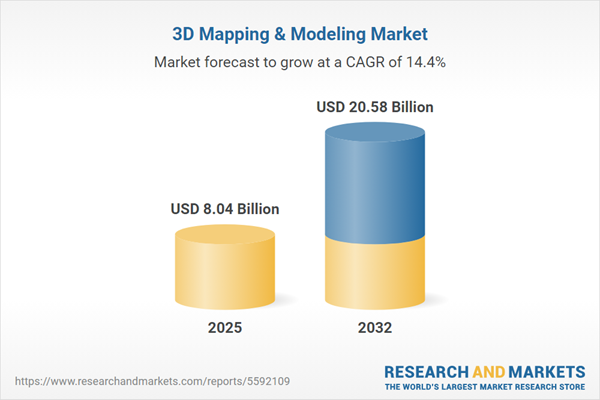Speak directly to the analyst to clarify any post sales queries you may have.
Senior executives face rising demands for precise spatial intelligence and operational efficiency. The global landscape is witnessing a growing shift toward 3D mapping & modeling solutions, as organizations look to enhance agility and secure a competitive edge in digital transformation. Robust 3D mapping platforms play a critical role in helping businesses address complex spatial challenges across diverse industries.
Market Snapshot: 3D Mapping & Modeling Market
Propelled by expanding adoption of geospatial analytics and evolving technology platforms, the worldwide 3D mapping & modeling market maintains a trajectory of steady growth. Organizations utilize these solutions to improve real-time situational awareness, ensuring streamlined management of intricate projects. Core applications include urban planning, construction oversight, asset tracking, workforce training, and risk assessment. As businesses adapt to dynamic regulatory landscapes, the integration of 3D mapping technology supports greater data consistency, resource optimization, and operational resilience, driving sustainable value for forward-thinking enterprises.
Scope & Segmentation of the 3D Mapping & Modeling Market
- Technology Solutions: Includes laser scanning, drone and satellite photogrammetry, LiDAR, and SLAM algorithms for collecting detailed spatial data, supporting both mission-critical operations and day-to-day business workflows.
- Applications: Covers heritage preservation, disaster simulation and risk management, autonomous vehicle development, smart city initiatives, immersive workforce training, and digital content creation, highlighting the technology's broad use across sectors.
- End Users: Spans automotive, construction, transportation, engineering, government, mining, defense, energy, and media industries, each leveraging 3D spatial intelligence to improve efficiency, compliance, and decision-making.
- Deployment Modes: Features cloud-based collaboration for distributed teams with real-time data updates, as well as on-premises solutions ensuring data control and compliance for sensitive environments.
- Pricing Models: Presents license-based, subscription, and pay-per-use options, enabling organizations to align expenditures with project demands and financial strategies.
- Vertical Industries: Real estate, environmental services, utilities, logistics, and infrastructure sectors adopt geospatial systems to increase productivity, foster competitiveness, and navigate evolving market needs.
- Regional Coverage: Encompasses the Americas, EMEA, and Asia-Pacific, with market expansion influenced by regional regulatory environments and differing maturity levels in countries such as the United States, Germany, UAE, India, and Australia.
- Leading Companies: Major vendors include Autodesk, Dassault Systèmes SE, Hexagon AB, Trimble Inc., Bentley Systems, Topcon Positioning, ESRI, TomTom, NavVis GmbH, and Matterport, Inc., delivering scalable solutions tailored for enterprise-scale implementation.
Key Takeaways for Senior Decision-Makers
- The integration of artificial intelligence and machine learning accelerates data extraction and analysis, resulting in timelier, actionable insights for strategic decision-making.
- Cloud-enabled 3D mapping solutions facilitate seamless collaboration and execution across distributed teams and complex stakeholder environments, benefiting sectors such as construction and public administration.
- Edge analytics capabilities enable real-time data processing at the source, improving overall system reliability and supporting operations in remote or industrial settings where uninterrupted service is essential.
- Digital twin technology empowers teams to model operational scenarios, optimize project planning, and address sustainability goals, driving improved outcomes through simulation and iterative refinement.
- Open standards and interoperability frameworks ensure smooth integration of both legacy and new systems, supporting regulatory compliance and unity across enterprise divisions.
Tariff Impact: United States Trade Policy Implications
- Shifts in tariffs on sensors and LiDAR components prompt organizations to evaluate supply chains, reduce exposure to cost fluctuations, and plan for potential sourcing limitations driven by regulatory changes.
- An increased emphasis on domestic production enhances resilience and consistency of supply, supporting continuous operations amid evolving international sourcing dynamics.
- Flexible procurement approaches, such as asset-as-a-service and modular purchasing, allow enterprises to respond quickly to both regulatory evolution and shifting market requirements.
Methodology & Data Sources
This analysis draws on expert interviews, peer-reviewed publications, regulatory documents, technical literature, and enterprise-level surveys. The multi-source approach ensures the findings reflect the most relevant technology trends, adoption patterns, and best operational practices in the sector.
Why This Report Matters
- Empowers leadership with data-driven recommendations that connect spatial technology investments directly to organizational objectives and digital strategy.
- Delivers in-depth segmentation and geographic analysis, providing benchmarks for effective risk assessment and strategic planning.
- Equips organizations to boost operational resilience and promote collaboration across sectors amid rapidly shifting compliance expectations.
Conclusion
Leveraging advanced 3D mapping & modeling solutions enables organizations to enhance geospatial intelligence and streamline workflows, supporting long-term agility and sustained business value throughout digital transformation.
Additional Product Information:
- Purchase of this report includes 1 year online access with quarterly updates.
- This report can be updated on request. Please contact our Customer Experience team using the Ask a Question widget on our website.
Table of Contents
3. Executive Summary
4. Market Overview
7. Cumulative Impact of Artificial Intelligence 2025
List of Figures
Companies Mentioned
The companies profiled in this 3D Mapping & Modeling market report include:- Autodesk, Inc.
- Dassault Systèmes SE
- Hexagon AB
- Trimble Inc.
- Bentley Systems, Incorporated
- Topcon Positioning Systems, Inc.
- Environmental Systems Research Institute, Inc.
- TomTom International B.V.
- NavVis GmbH
- Matterport, Inc.
Table Information
| Report Attribute | Details |
|---|---|
| No. of Pages | 195 |
| Published | November 2025 |
| Forecast Period | 2025 - 2032 |
| Estimated Market Value ( USD | $ 8.04 Billion |
| Forecasted Market Value ( USD | $ 20.58 Billion |
| Compound Annual Growth Rate | 14.3% |
| Regions Covered | Global |
| No. of Companies Mentioned | 11 |









